GHOST IN THE SHELL: Impressive Visuals Not Enough To Save This Bland, Hollywoodized Remake
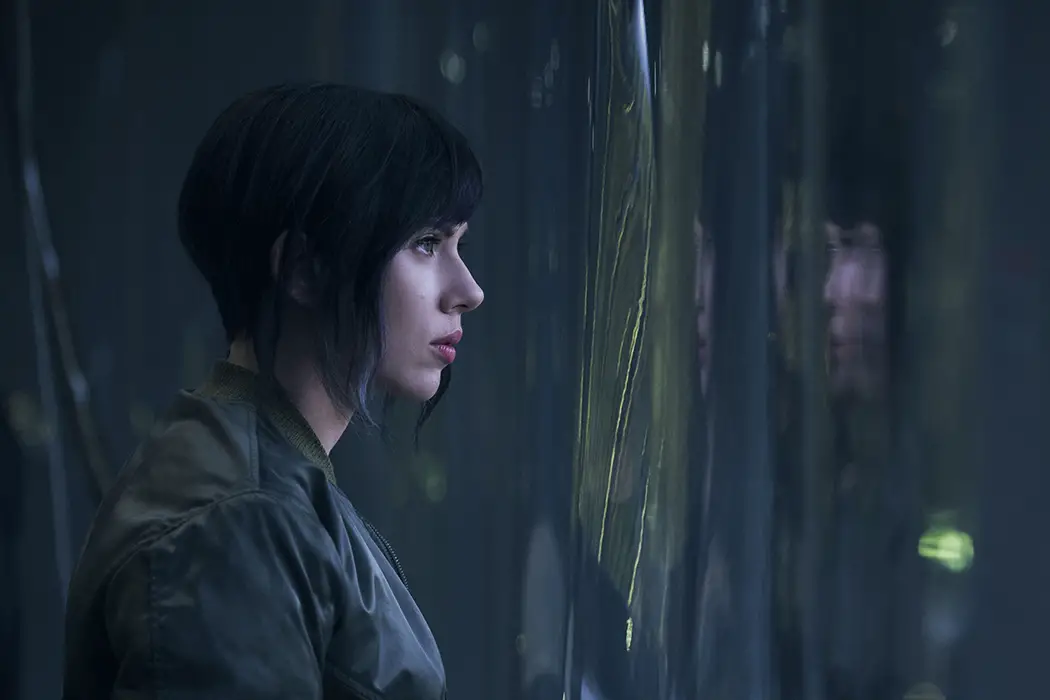
David is a film aficionado from Colchester, Connecticut. He enjoys…
It’s demonstrative that Ghost in the Shell ultimately turned out to be a failure. Not only was the film plagued by claims of white-washing from the get-go, but it also came at a really poor time. The original Ghost in the Shell premiered in 1995, and as is typical following a groundbreaking success, many similarly-minded films followed suit over the next several years: The Matrix, AI: Artificial Intelligence, Avatar.
Now, years after these and many other films came and stretched the cybernetic theme to its supposed limits, and in addition, when such prospects are becoming increasingly likely in our own world, a live-action remake of that 1995 film rears its face. And, rather than stretch the capacity of the original’s themes, it instead shrinks them down to eye level, becoming a forgettable and ultimately pointless endeavor.
Constructing a Story
Ghost in the Shell takes place in the year 2029. Cybernetics are all the rage in this not-too-distant future, in which people replace parts of their bodies with high-tech robotics, bringing them to the peak of physical proficiency while at the same time blurring the lines between humanity and machines. The latest in the line of robotic technology by the company Hanka Robotics is the aptly named The Major (Scarlett Johansson), a human-robot hybrid that is distinctive due to only having a human brain still intact, with the remainder of her body being robotic. Brought back to life after her untimely death from a terrorist attack, she has now been assigned to work for Section 9, whose mission is to bring to justice like-minded criminals.
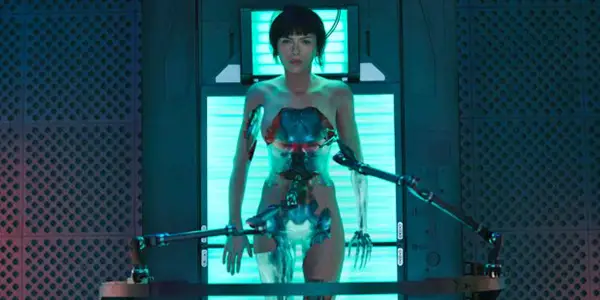
Flash-forward to a year later, and a prominent criminal named Kuze (Michael Pitt) is a major threat, focused on taking out high-level leaders of Section 9. An encounter between him and The Major leads to her questioning her true role within the company that supposedly helped not only bring her back to life, but gave her a purpose moving forward. The remainder of the film then follows The Major’s hunt to discover the truth about her identity.
Colorful Yet Excessive
What is immediately evident about Ghost in the Shell, much as in the original film, is the cyberpunk, digitized world in which these characters live. Indeed, even more so than the anime, this world is teeming with virtual life, complete with moving holograms as large as skyscrapers, neon multi-colored lights which animate entire cities, and even the people themselves, such as The Major, whose color-changing Rorschach suit makes her appear straight out of a video game. It’s a feast for the eyes, with a lot of varying background images and contours to examine at any given moment.
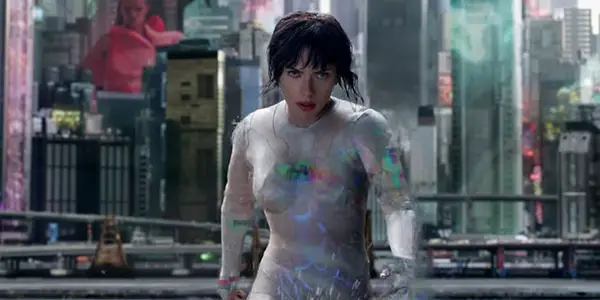
Yet, in a way, the film is almost too visual. Whereas in the original anime, it’s easy to suspend your disbelief and simply accept this cyberpunk world as reality, here, in a live-action remake with real actors playing the parts, the images around them feel so computerized and digital that it never grounds itself in the real world. This is no Matrix, where people get plugged into a device and a virtual world appears around them; instead, they always seem to be living within it, which detracted from the film’s total immersive potential.
In addition to often appearing more illusionary than real, the visuals of Ghost in the Shell can be distracting. An example is during one scene, when a character is being chased down by two garbage men, and in the background was looming a large holographic image, which subsequently diverted my attention to that corner of the screen. In the process, I partly missed the action which should have instead been front and center. In this way, the expansive digital world, despite impressive CGI, is too much fluff in a film that needed to focus more on creating compelling characters and an engaging story-line.
None of this is particularly helped by the performances which surround the experience. Scarlett Johansson, who seems to have a preference for these types of roles, having played the superhuman-enhanced title character in Lucy and the oddly entrancing alien in Under the Skin, here seems to be playing a hybrid of the two. It’s fitting, since her character is somewhere between a human and an emotionless robot, yet she doesn’t have any discernible change in her demeanor or mannerisms as the film progresses, perhaps also due in part to the film’s script and direction by Rupert Sanders. From the opening scene, she’s simply a confused human with a robotic tone that also possesses enhanced strength and agility, and by the conclusion, though her character has changed, Johannson doesn’t appear to have changed with her.
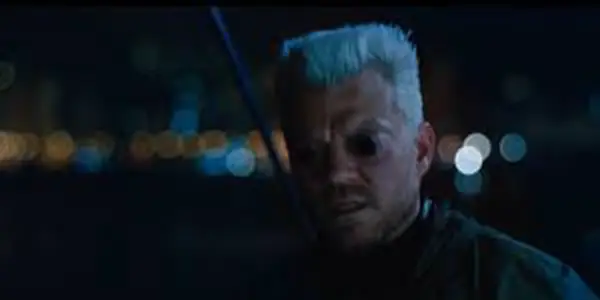
The supporting roles include Pilou Asbæk as her partner Batou, a character from the original Japanese manga and anime film. Though physically resembling the role, down to the bleached-blonde hair and eerily striking tunnel vision eyes, Asbæk is also wasted as a supporting character, never quite achieving the level of camaraderie through his dialogue with The Major as he does in the original film.
Much of the cast is wasted in a similar manner, including characters played by Michael Pitt, Takeshi Kitano, Chin Han, and Juliette Binoche. This is no particular fault on the talent of the cast; instead it is largely due in part to the film’s confused and muddled attempt to both capture and distinguish itself from the Japanese anime.
Different, But Not in a Good Way
Ghost in the Shell is, admirably, not a carbon copy of the original Japanese film. There are a few scenes which are clear homages to it, including, among others, an enlightening conversation that takes place after The Major decides to go swimming, a chase scene which ends while wading through water behind a wall of buildings, and a final battle against a swiftly moving spider-like tank.
Besides these, the film distinguishes itself just enough by having a unique background for its characters, in particular for The Major. In the original anime, this character was simply a prolific assault-team leader named Motoko Kusanagi, who, while also cybernetically enhanced, worked to bring down terrorists under her own free will. The Major, on the other hand, is essentially an unwitting slave, and though both characters ally with the terrorist by the film’s conclusion, The Major does so for an entirely different reason than Kusanagi.
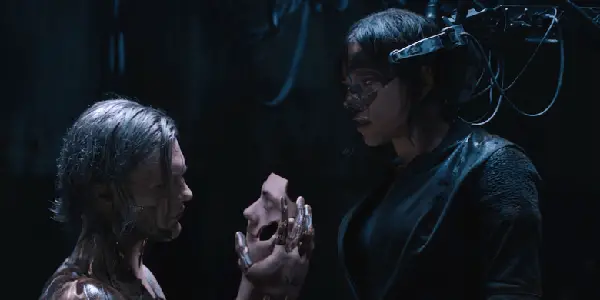
And this brings to light the film’s largest indicator of lost potential. By the conclusion of the anime, the film had transposed from a simple (though visually stunning) action anime into one of transience, bringing to mind philosophical ideals ranging from thought and conscience to our dependence and merging with technology to the very essence of what makes us human. By the conclusion of the American remake, conversely, the film had transposed from an action film to an even more generic action film. The motives and deeper meanings which imbue the characters as they make their final choices are now grounded in something that you could find in any typical genre fare, and though I won’t spoil it here, just take a shot in the dark and you’ll likely guess what they are.
One more thing: there is an attempt by the conclusion of Ghost in the Shell to “explain” the reason that the main characters are Caucasian instead of Japanese. Whether or not this was the original intention by the filmmakers before claims of white-washing is, to me, unknown. But, rather than make it seem acceptable that these characters who were clearly Japanese in the original stories are now white, instead it seems like a rather shoehorned attempt to make this aspect an actual part of the story. I have tried, before now, to avoid much discussion of white-washing within my review as an outright criticism, as it seems just too easy. But this one particular detail was so glaringly blatant that I couldn’t help but at least mention it.
Conclusion
To conclude, Ghost in the Shell lacks the originality and thought-provoking qualities of the original Japanese anime. With visuals that are undeniably impressive, yet also frequently invasive to the senses, and a story that eventually treads into unremarkable action genre territory, it is an unfortunate missed opportunity. To bring up the phrase that seems synonymous with it (and indeed, is the name of another, though otherwise entirely different Scarlett Johansson film): it is a movie very much lost in translation.
What are some of your favorite American remakes? Tell us what you thought in the comments below!
Does content like this matter to you?
Become a Member and support film journalism. Unlock access to all of Film Inquiry`s great articles. Join a community of like-minded readers who are passionate about cinema - get access to our private members Network, give back to independent filmmakers, and more.
David is a film aficionado from Colchester, Connecticut. He enjoys writing, reading, analyzing, and of course, watching movies. His favorite genres are westerns, crime dramas, horror, and sci-fis. He also enjoys binge-watching TV shows on Netflix.













